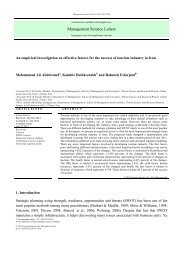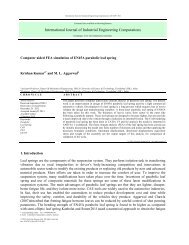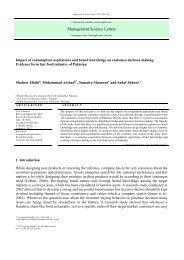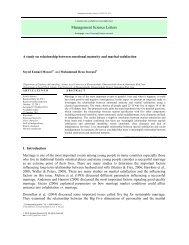PDF (276 K) - Growing Science
PDF (276 K) - Growing Science
PDF (276 K) - Growing Science
You also want an ePaper? Increase the reach of your titles
YUMPU automatically turns print PDFs into web optimized ePapers that Google loves.
M. Kazemi et al. / International Journal of Industrial Engineering Computations 3 (2012)<br />
(i) Xij > Xij+1. By (10), XPij - XMij > 0. Since this is a minimization problem and the objective<br />
function cost coefficients are strictly positive, XMij = 0 and XPij = Xij - Xij+1 will hold in the<br />
optimal solution.<br />
(ii) Xij < Xij+1. By (10), XPij - XMij < 0. In this case, again with the coefficients of XPij and XMij<br />
being strictly positive, the objective function will ensure that XPij = 0 and thus XMij = Xij+1 -<br />
Xij will hold in the optimal solution.<br />
(iii) Xij = Xij+1. By (10), XPij - XMij = 0. In this case, both XPij = 0 and XMij = 0 will hold in the<br />
optimal solution since their coefficients in the objective function are strictly positive.<br />
Appendix B. The Proof of proposition 2<br />
Consider the following two cases:<br />
(i) Xij .(Ci - j) = 0. Such a situation arises under one of the following three sub-cases:<br />
(a) Xij = 1 and (Ci - j) = 0. ∀ i, j;<br />
(b) Xij = 0 and (Ci - j) > 0. ∀ i, j;<br />
(c) Xij = 0 and (Ci - j) = 0. ∀ i, j;<br />
In all of the three sub-cases given above, the value of Mij = 0, because in these cases, constraint<br />
(11) implies Mij ≥ 0 or -∞ and since Mij has a strictly positive cost coefficient, the minimizing<br />
objective function ensures that Mij = 0.<br />
(ii) Xij .(Ci - j) = (Ci - j) > 0. ∀ i, j;<br />
Such a situation arises when Xij = 1 and (Ci - j) > 0 so, constraint (11) implies Mij ≥ (Ci - j) and<br />
since Mij has a strictly positive cost coefficient, the minimizing objective function ensures that<br />
Mij = (Ci - j).<br />
Appendix C. The Proof of proposition 3<br />
Consider the following two sections:<br />
(i) In term max( X . j ) , we find the final position of process for job i, thus in constraint (12.2),<br />
j<br />
ij<br />
when for the final position, for example position j, Xij = 1, then Qij takes value j and for the<br />
following positions which are larger than j, Xijs take value 0, then Qij finally turns value j<br />
which implies the final position of process in constraint (12.2).<br />
(ii) The non-linear constraint (12.2) can be liberalized by the following transformations<br />
1 . Qij − X ij = Rij<br />
and j . X ij = Fij<br />
, under the following sets of constraints:<br />
and<br />
Rij ≤ Qij−1 + A(1 − Xij) ∀ i, j;<br />
(12.3)<br />
Rij ≥Qij−1 − A(1 − Xij ) ∀ i, j;<br />
(12.4)<br />
R ≤ AX . ∀ i, j;<br />
(12.5)<br />
ij ij<br />
333








